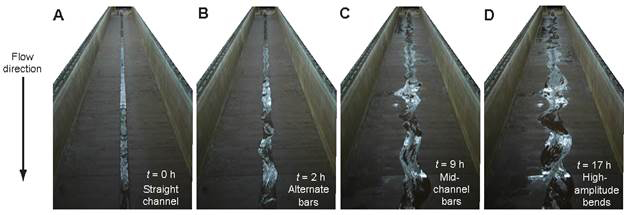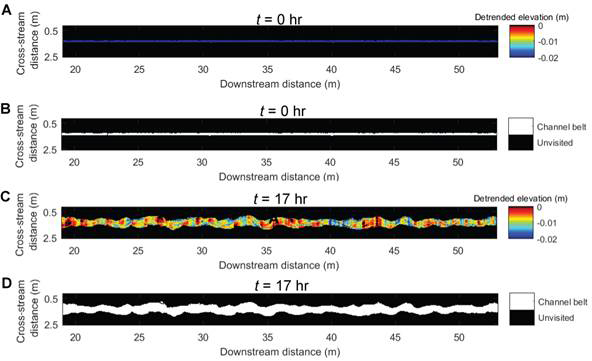Reports: ND856832-ND8: Linking River Channel Dynamics to the Dimensions of Channel Belts
Chris Paola, University of Minnesota
1. Introduction
Over millennia, rivers imprint broad corridors of the landscape. These channel belts are commonly preserved as coarse-grained sedimentary deposits and represent key hydrocarbon reservoirs. This project focuses on linking observable channel dynamics to the dimensions of channel belts. We have begun a set of interrelated tasks to (1) quantify channel dynamics, using laboratory experiments; (2) use these observations to generate a new numerical model for channel belt evolution; and (3) compare natural channel belt dimensions to predictions from the experiments and modeling. In year 1 of the project, we have focused on the first two tasks.
2. Research Progress
We are conducting the physical experiments in a large flume (2.7 m wide, 40 m long) at St. Anthony Falls Laboratory. This flume typically conveys flows that span its full width, but has enough room to evolve a small alluvial channel without constraints from flume walls. To realize this possibility, we designed and tested several changes to the flume. We first manually increased the bed slope from < 0.001 to 0.01 (Fig. 1A). We then then used a custom-built screed to smooth the surface (Fig. 1B).
Figure 2 shows the experiment design. Water reservoirs are located at both ends of the flume in order to saturate sediment pore space and fix base level (Fig. 2A). We introduced water from a constant-head tank, and sediment from a sediment feeder at rates of 0.2 L/s and 0.001 L/s, respectively. Flow proceeded through a straight, initial channel in the center of the flume (Fig. 1B). The initial channel cross-section is rectangular (18 cm wide by 3 cm deep; Fig. 1C).
Figure 3 shows the evolution of the channel during the first run, for a run time of 20 hours. Starting from the initial channel shape (Fig. 3A), the channel widened and decreased in depth. Alternating bars developed (Fig. 3B), and the thalweg developed meanders with a quasi-uniform wavelength of 1.8 meters. Mid-channel bars then appeared discontinuously along the channel (Fig. 3C). By 17 hours run time, high-amplitude channel bends and a multi-thread channel pattern developed along the full length of the flume (Fig. 3D).
We collected elevation data every hour after drying the sediment bed. Figures 4a-4f show a subset of the topography data gathered during the experiment. We mapped the channel belt from the topography data by automatically identifying areas that changed in elevation during the run. The channel belt widened with time as the channel visited new areas (Fig. 5). Year 2 experiments will focus on belt width evolution under varying input conditions.
We are also developing a new reduced-complexity model for channel-belt development in multi-thread rivers. The model builds on previous models for river meandering that treat channel threads as coherent objects migrating in response to non-local curvature effects. Our framework adapts these concepts to a channel with multiple threads. We are testing new model components to track the geometry of multiple channel threads and to treat the interaction of channel migration and curvature effects between channel threads. We will iterate on the numerical model design to incorporate insights from the laboratory experiments. We plan to synthesize the model, experiment, and field data in the second half of Year 2.
3. Impact of the research
We believe our physical experiments are the first to simultaneously (1) evolve channels without constraining flume walls, (2) develop the channels over tens of channel widths downstream, and (3) capture channel evolution from straight to braided using high-resolution topography. We expect that these experimental data and related numerical model will clarify how river corridors evolve across a range of temporal and spatial scales.
Through this project, Postdoctoral Associate Ajay Limaye has gained new experience in designing and executing a large-scale sediment dynamics experiment. He has gained exposure to new scientific problems in channel dynamics, and will present the research at national conferences and peer-reviewed publications starting this fall. The research impacts PI Paola by enabling a new line of study in channel-belt dynamics over geologic timescales. In the next year, Paola will also explore a new research direction by working with Limaye to interpret remote sensing data of natural channel belts and relate them to predictions from the modeling and experiments.
Figures
Figure 1. (A) Downstream-looking view of the flume during slope construction of the sediment bed. For scale, a person stands at the downstream end. (B) Sediment bed after levelling.
Figure 2. Schematics of the experiment setup. Coordinates x, y, and z correspond to the downstream, cross-stream, and vertical directions, respectively. (A) A cross-section oriented perpendicular to the flow direction. (B) Overhead view. (C) A cross-section oriented parallel to the flow direction. Bull’s eye indicates flow out for the page, emanating from the initial channel cross-section.
Figure 3. A time-series of upstream-looking images. The channel evolves from straight to braided. (A) t = 0 hours. (B) t = 2 hours. (C) t = 9 hours. (D) t = 17 hours.
Figure 4. Overhead views of elevation and channel belt extent during the experiment run. Scale and extent are fixed in all panels. Topography data is detrended and masked by the extent of the channel belt. (A) Detrended elevation at the start of the run (t = 0 hours). The initial channel is blue, and surrounding areas are black. (B) The extent of the channel belt (white) compared to unvisited areas (black) at t = 0 hours. (C) Detrended elevation for t = 17 hours. (D) The extent of the channel belt at t = 17 hours.
Figure 5. Width of channel belt vs. downstream distance. Colors indicate the experiment run time in hourly intervals up to t = 17 hours. The channel belt width is approximately constant at t = 0 hours (blue). The average width of the channel belt and the amplitude of oscillations in channel belt width both increase up to t = 17 hours (yellow).
















